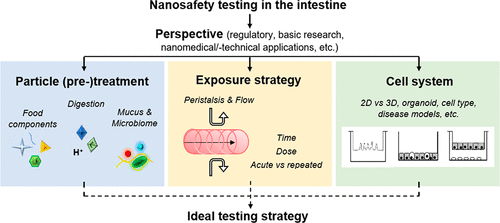当前位置:
X-MOL 学术
›
Chem. Res. Toxicol.
›
论文详情
Our official English website, www.x-mol.net, welcomes your
feedback! (Note: you will need to create a separate account there.)
Advanced In Vitro Testing Strategies and Models of the Intestine for Nanosafety Research.
Chemical Research in Toxicology ( IF 3.7 ) Pub Date : 2020-05-08 , DOI: 10.1021/acs.chemrestox.0c00079 Angela A M Kämpfer 1 , Mathias Busch 1 , Roel P F Schins 1
Chemical Research in Toxicology ( IF 3.7 ) Pub Date : 2020-05-08 , DOI: 10.1021/acs.chemrestox.0c00079 Angela A M Kämpfer 1 , Mathias Busch 1 , Roel P F Schins 1
Affiliation

|
There is growing concern about the potential adverse effects of oral exposure to engineered nanomaterials (ENM). Recent years have witnessed major developments in and advancement of intestinal in vitro models for nanosafety evaluation. The present paper reviews the key factors that should be considered for inclusion in nonanimal alternative testing approaches to reliably reflect the in vivo dynamics of the physicochemical properties of ENM as well the intestinal physiology and morphology. Currently available models range from simple cell line-based monocultures to advanced 3D systems and organoids. In addition, in vitro approaches exist to replicate the mucous barrier, digestive processes, luminal flow, peristalsis, and interactions of ENM with the intestinal microbiota. However, while the inclusion of a multitude of individual factors/components of particle (pre)treatment, exposure approach, and cell model approximates in vivo-like conditions, such increasing complexity inevitably affects the system's robustness and reproducibility. The selection of the individual modules to build the in vitro testing strategy should be driven and justified by the specific purpose of the study and, not least, the intended or actual application of the investigated ENM. Studies that address health hazards of ingested ENM likely require different approaches than research efforts to unravel the fundamental interactions or toxicity mechanisms of ENM in the intestine. Advanced reliable and robust in vitro models of the intestine, especially when combined in an integrated testing approach, offer great potential to further improve the field of nanosafety research.
中文翻译:

用于纳米安全性研究的肠道高级体外测试策略和模型。
口腔接触工程纳米材料(ENM)的潜在不利影响日益引起人们的关注。近年来,见证了用于纳米安全性评估的肠道体外模型的重大发展和进步。本文概述了关键因素,应考虑包括在非动物替代测试方法中,以可靠地反映ENM的理化特性的体内动力学以及肠道的生理和形态。当前可用的模型范围从简单的基于细胞系的单一培养到先进的3D系统和类器官。此外,存在体外方法来复制粘液屏障,消化过程,管腔流量,蠕动以及ENM与肠道菌群的相互作用。然而,尽管包括粒子(预处理),暴露方法和细胞模型的众多单个因素/组件近似于体内条件,但这种复杂性的提高不可避免地会影响系统的耐用性和可重复性。应根据研究的特定目的,尤其是所研究的ENM的预期或实际应用,来驱动和证明选择用于构建体外测试策略的各个模块。解决摄入ENM对健康的危害的研究可能需要与研究工作不同的方法,以弄清ENM在肠道中的基本相互作用或毒性机制。先进的可靠且健壮的肠道体外模型,尤其是在集成测试方法中结合使用时,
更新日期:2020-05-08
中文翻译:

用于纳米安全性研究的肠道高级体外测试策略和模型。
口腔接触工程纳米材料(ENM)的潜在不利影响日益引起人们的关注。近年来,见证了用于纳米安全性评估的肠道体外模型的重大发展和进步。本文概述了关键因素,应考虑包括在非动物替代测试方法中,以可靠地反映ENM的理化特性的体内动力学以及肠道的生理和形态。当前可用的模型范围从简单的基于细胞系的单一培养到先进的3D系统和类器官。此外,存在体外方法来复制粘液屏障,消化过程,管腔流量,蠕动以及ENM与肠道菌群的相互作用。然而,尽管包括粒子(预处理),暴露方法和细胞模型的众多单个因素/组件近似于体内条件,但这种复杂性的提高不可避免地会影响系统的耐用性和可重复性。应根据研究的特定目的,尤其是所研究的ENM的预期或实际应用,来驱动和证明选择用于构建体外测试策略的各个模块。解决摄入ENM对健康的危害的研究可能需要与研究工作不同的方法,以弄清ENM在肠道中的基本相互作用或毒性机制。先进的可靠且健壮的肠道体外模型,尤其是在集成测试方法中结合使用时,











































 京公网安备 11010802027423号
京公网安备 11010802027423号